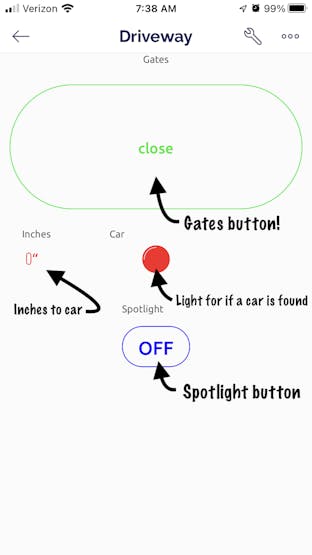Created October 5, 2022 © MIT
Automated Driveway Gates Version 2
This is a second tutorial for making DIY automated driveway gates for relatively cheap using Arduino, ESP32, Raspberry Pi, and Blynk!
Level: Intermediate
Work in progress
Time to build: 5 hours
Things used in this project
Hardware components
DFRobot FireBeetle ESP32 ×1 DFRobot 2x15A Motor DriverThis product is now discontinued. This product is a good equivalent: https://www.dfrobot.com/product-1861.html?tracking=wrvW2zWgzSBdRH8U94Hohk2UquGYvPgFFtGJgEKdKSuZRlj9IzpymV0Oa7jM0Ywv×1 DFRobot Waterproof Ultrasonic Sensor ×1 RGB LED Strip (Not Individually Addressable)I got 2x IP65 LED Flex Strip RGB 60LEDs/Meter 16.4 Foot; both of my gates are 12ft long.×1 LD1117V33 3.3V LDO ×1  Capacitor 10 µF ×2 12V 350W Power Supply ×1 DFRobot 50A Current Sensor ×1
Capacitor 10 µF ×2 12V 350W Power Supply ×1 DFRobot 50A Current Sensor ×1
Software apps and online services
Hand tools and fabrication machines
 Soldering iron (generic)
Soldering iron (generic)  Solder Wire, Lead Free
Solder Wire, Lead Free  Drill / Driver, Cordless
Drill / Driver, Cordless
Story
The Story
Hello!
This tutorial is a second version of my previous award winning Automated Driveway Gates project. It includes new upgraded linear actuators that have built-in hall sensors, a new mainboard consisting of an ESP32, a new double motor driver module capable of 15A @ 13.8V per channel, and a new waterproof ultrasonic sensor!
The Parts
As I just explained, there are many new and better components in this build.
2x PA-04-HS 12V 12A IP65 Hall Effect Linear Actuators ( I also bought both bracket types)1x DFRobot FireBeetle ESP321x DFRobot 2x15A Motor Driver (now discontinued, but they have a new version capable of 12A per channel)1x DFRobot 50A AC/DC Current Sensor1x DFRobot Waterproof Ultrasonic Sensor1x LD1117v33 3.3V 800mA voltage regulator IC2x 10µF Electrolytic Capacitors for the regulator1x 12V 350W Power Supply2x 12V IP65 RGB LED Strips4x NPN MOSFETs (I use STP90NF03L)
DFRobot
Dfrobot is an awesome electronics company! They kindly sponsored their parts to me for this project. They have anything you could need for any project of every type! You can check my other projects for more awesome things you can build with their parts. Check them out here! https://www.dfrobot.com
Wiring
The wiring may look complicated, but is pretty straightforward once you dive in ?.
Motor Driver - FireBeetle:
M2Speed - IO17M2Dir - IO13M1Speed - IO16M1Dir - IO14+5V - VCCGND - GND
Ultrasonic Sensor - FireBeetle:
+3.3V - +3.3VGND - GNDRX - IO22TX - IO21
Spot Light - FireBeetle:
Transistor Gate - IO12
LED Strips - FireBeetle:
1st transistor gate - IO252nd transistor gate - IO273rd transistor gate - IO5
Magnet Lock - FireBeetle:
Transistor Gate - IO2
Current Sensor - FireBeetle:
AO - A0
If this description doesn't make sense (I would totally agree), you can follow the schematic that I drew:
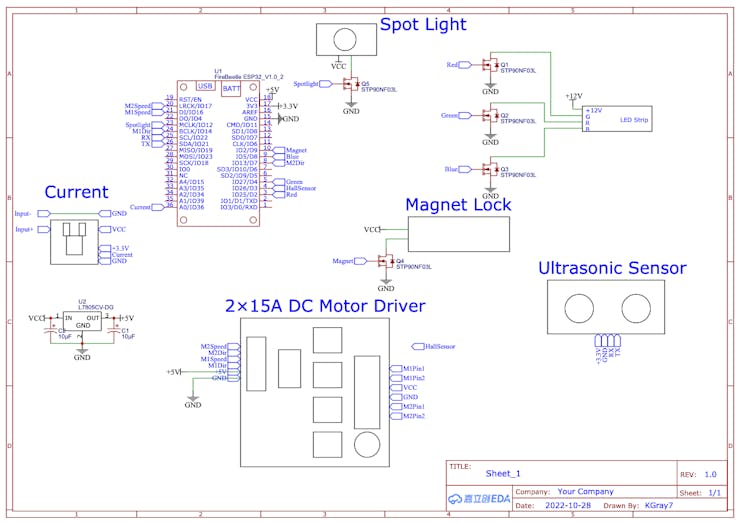
Schematic
Blynk
Blynk has been updated ?! Personally, I don't like the new version; it is harder to use, has less features than the previous one, and is pricey.
This is how the desktop template should look when completed:
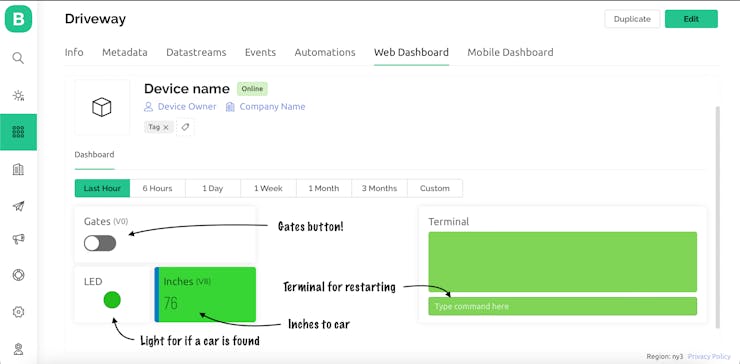
Here is the mobile app Template:
If you need help setting up Blynk, refer to the documentation found here:
Code
The code is quite long for this project! Keep in mind that you will probably have to change some things to get it to work how you would like for your setup. For example, my left actuator seemed to open slower than it closed, so I had to adjust the opening and closing functions to account for that. For a full code description, please check out the original Hackster project here: https://www.hackster.io/k-gray/automated-driveway-gates-version-2-6d9b2e
Wrapping Up
Finished box:
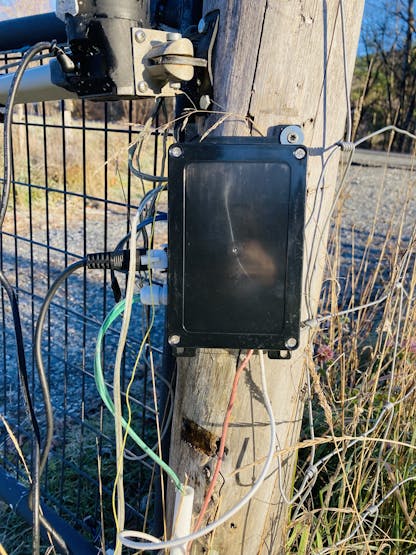
Finshed box with everything wired.
That was all for this tutorial! If you liked it, give it a thumbs up! Please feel free to post in the comments for any questions, ideas, advice, suggestions, and so on!
Check out this link for more awesome projects:
https://www.hackster.io/k-gray
Schematics
Schematic
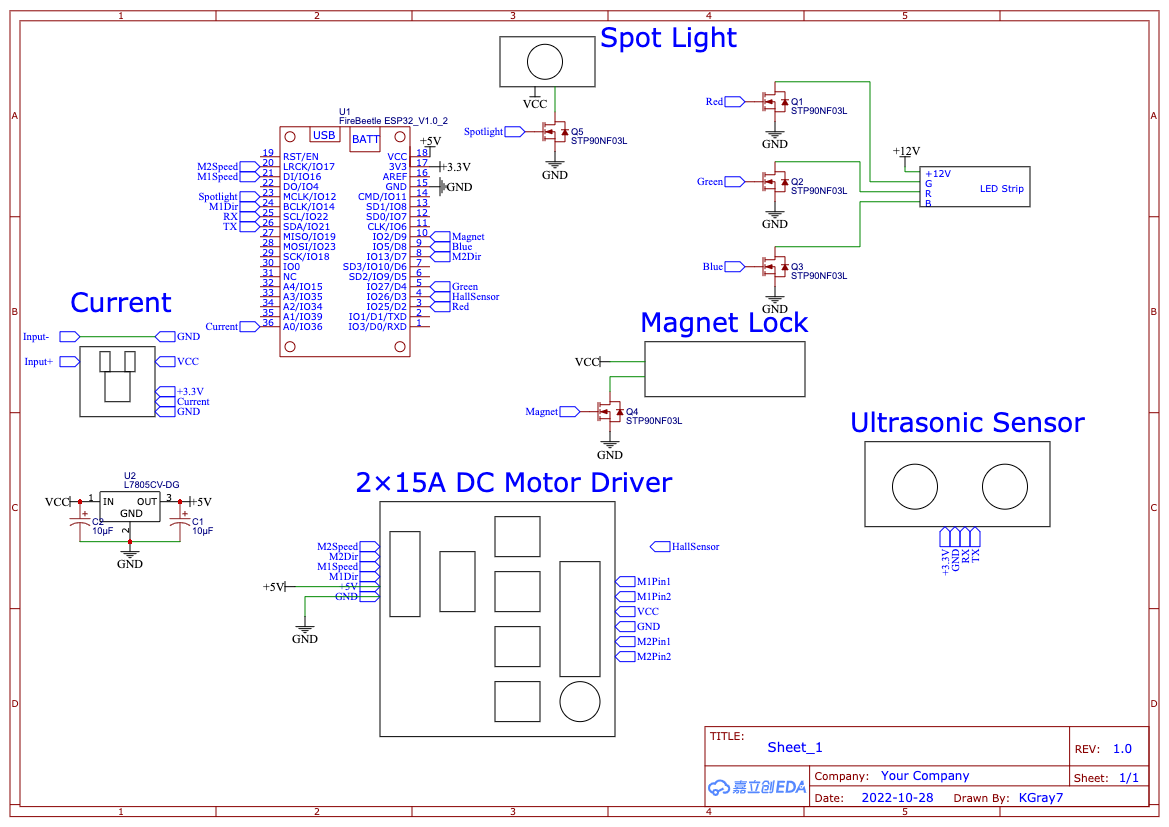
Code
GitHub Repository
Kgray44 / Automated-Driveway-Gate-Updated
This is an updated project of my Automated--Driveway-Gates! — Read More
https://www.hackster.io/k-gray/automated-driveway-gates-version-2-6d9b2e
Latest commit to the master branch on 10-28-2022
#define BLYNK_TEMPLATE_ID "************"
#define BLYNK_DEVICE_NAME "********"
#define BLYNK_AUTH_TOKEN "*******************************"
#define BLYNK_PRINT Serial
#include <WiFi.h>
#include <WiFiClient.h>
#include <BlynkSimpleEsp32.h>
#include <WiFiUdp.h>
#include <ArduinoOTA.h>
#include <SoftwareSerial.h>
#define motorAspeed 16//D11
#define motorBspeed 17//D10
#define motorAdir 14//D6
#define motorBdir 13//D7
#define hall 26//D3
#define ultra1 22
#define ultra2 21
#define currentIn A0
#define pinRed D4
#define pinGreen D3
#define pinBlue 4//D12
#define magnet D9//D13
#define light 4//D12
/* Current Sensor (currently not working)
const int numReadings = 30;
float readings[numReadings]; // the readings from the analog input
int inde = 0; // the inde of the current reading
float total = 0; // the running total
float average = 0; // the average
float currentValue = 0;
*/
int ppi = 300; //pulses per inch (for the PA-04 Linear Actuator). Change this according to your specs.
int usedAct = 6; //inches of actuator used
char ssid[] = "************";//WiFi network name
char pass[] = "********";//WiFi network password
//Gate button value for Blynk
int button;
int timer;
//current sensor value
float voltage;
//ultrasonic sensor
unsigned char data[4] = {};
float distance;
float inches;
int car;
int carDist = 24;//alter this value! This value is distance in inches before something is activated
int tim = 10000;
long hallCount;
//gate status flag
boolean flag = false;
//LED strip starting values
int red = 255;
int green = 255;
int blue = 255;
SoftwareSerial ultraSerial;
//BLYNK_CONNECTED(){
// Blynk.syncAll();
//}
BLYNK_WRITE(V0){
button = param.asInt();
}
BLYNK_WRITE(V1){
red = param.asInt();
}
BLYNK_WRITE(V2){
green = param.asInt();
}
BLYNK_WRITE(V3){
blue = param.asInt();
}
BLYNK_WRITE(V4){
int spotlight = param.asInt();
if (spotlight){
digitalWrite(light, HIGH);
}
else {
digitalWrite(light, LOW);
}
}
String string;
BLYNK_WRITE(V10) {
string = param.asStr();
if (string == "restart"){
Blynk.virtualWrite(V10, "Restarting...");
Serial.println("Restarting...");
delay(2000);
ESP.restart();
}
}
//gate status flag
boolean isOpen = false;
//PWM information
const int freq = 5000;
const int resolution = 8;
const int redChannel = 1;
const int greenChannel = 2;
const int blueChannel = 3;
const int motorA = 4;
const int motorB = 5;
void setup() {
Serial.begin(115200);
ultraSerial.begin(9600, SWSERIAL_8N1, ultra1, ultra2, false); // RX, TX
if (!ultraSerial) { // If the object did not initialize, then its configuration is invalid
Serial.println("Invalid SoftwareSerial pin configuration, check config");
}
//set pinModes
pinMode(motorAspeed, OUTPUT);
pinMode(motorBspeed, OUTPUT);
pinMode(motorAdir, OUTPUT);
pinMode(motorBdir, OUTPUT);
pinMode(pinRed, OUTPUT);
pinMode(pinGreen, OUTPUT);
pinMode(pinBlue, OUTPUT);
pinMode(hall, INPUT_PULLUP);
pinMode(currentIn, INPUT);
pinMode(magnet, OUTPUT);
pinMode(light, OUTPUT);
//attach PWM channels to the correct pins
ledcAttachPin(pinRed, redChannel);
ledcAttachPin(pinGreen, greenChannel);
ledcAttachPin(pinBlue, blueChannel);
ledcAttachPin(motorAspeed, motorA);
ledcAttachPin(motorBspeed, motorB);
//setup the PWM channels
ledcSetup(redChannel, freq, resolution);
ledcSetup(greenChannel, freq, resolution);
ledcSetup(blueChannel, freq, resolution);
ledcSetup(motorA, freq, resolution);
ledcSetup(motorB, freq, resolution);
//connect to the WiFi
wificonnect();
//Start Blynk
Serial.println("Blynk Starting...");
Blynk.config(BLYNK_AUTH_TOKEN);
//Start OTA
Serial.println("OTA Starting...");
OTAStart();
//open the gates all the way at the beginning to set the hall sensor back at 0
Serial.println("Begin opening...");
delay(1000);
beginOpen();
hallCount = ppi*usedAct;
isOpen = true;
Serial.println("Attaching interrupt...");
attachInterrupt(digitalPinToInterrupt(hall), interruptName, FALLING);//Interrupt initialization
//then close to the correct place, keeping track of the hall count
Serial.println("Closing to correct place...");
close();
Serial.println("Done closing!");
Serial.println("Ready");
isOpen = false;
}
void loop() {
/*current sensor reading (currently not working)
currentVal();
if (currentValue >= 20.00){
ledcWrite(motorA, 0);
ledcWrite(motorB, 0);
digitalWrite(hall, HIGH);
Serial.println("Current too high!");
}
current = (analogRead(currentIn)-510)*5/1024/0.04-0.04;//calculate current value
Blynk.virtualWrite(V7,current);
*/
//if WiFi was lost, reconnect
if (WiFi.status() == WL_CONNECTION_LOST){
Serial.println("Connection lost...");
wificonnect();
}
//handle the OTA
ArduinoOTA.handle();
//ultrasonic sensor reading
for (int i=0;i<4;i++){
Serial.println("Checkdist();");
ArduinoOTA.handle();
checkDist();
}
Blynk.virtualWrite(V8,inches);
if (inches <= carDist){
Serial.println("Car");
Blynk.virtualWrite(V9, HIGH);
}
else {
Blynk.virtualWrite(V9, LOW);
}
//if Blynk button pressed, switch the flag
if (button == HIGH){
flag = !flag;
}
//check to see if the flag is true, then check if the gates are closed and open them
if (flag == true && isOpen == false) {
digitalWrite(magnet, LOW);
delay(100);
open();
isOpen = true;
}
//else, check to see if the gates are open, and close them
else if (flag == false && isOpen == true) {
close();
delay(100);
digitalWrite(magnet, HIGH);
isOpen = false;
}
//write the Blynk values to the LED strips
ledcWrite(redChannel, red);
ledcWrite(greenChannel, green);
ledcWrite(blueChannel, blue);
//run Blynk, yield() to prevent unwanted resets, and delay 1 millisecond to keep track of time
Blynk.run();
yield();
delay(1);
}
void wificonnect(){
Serial.println("WiFi Connecting...");
WiFi.mode(WIFI_STA);
WiFi.begin(ssid, pass);
while (WiFi.status() != WL_CONNECTED){
Serial.print(".");
delay(500);
delay(500);
}
Serial.println("");
while (WiFi.waitForConnectResult() != WL_CONNECTED) {
Serial.println("Connection Failed! Rebooting...");
delay(5000);
ESP.restart();
}
}
void checkDist(){
retry:
do {
for (int i = 0; i < 4; i++){
data[i] = ultraSerial.read();
}
}
while (ultraSerial.read() == 0xff);
ultraSerial.flush();
if (data[0] == 0xff)
{
int sum;
sum = (data[0] + data[1] + data[2]) & 0x00FF;
if (sum == data[3])
{
distance = (data[1] << 8) + data[2];
if (distance > 20)
{
inches = distance / 25.4; //mm to inches
Serial.print(distance / 10);
Serial.println("in");
} else
{
inches = 0;
Serial.println("Below the lower limit");
}
} else goto retry;//Serial.println("ERROR");
}
delay(100);
}
void beginOpen(){
bodo:
digitalWrite(motorAdir, HIGH);
digitalWrite(motorBdir, HIGH);
ledcWrite(motorA, 255);
ledcWrite(motorB, 255);
yield();
timer++;
delay(1);
while (timer < 24000){
yield();
goto bodo;
}
timer = 0;
Serial.println("Done!");
ledcWrite(motorA, 0);
ledcWrite(motorB, 0);
}
void open(){
int times=0;
hallCount = 0;
redo:
digitalWrite(motorAdir, HIGH);
digitalWrite(motorBdir, HIGH);
ledcWrite(motorA, 255);
ledcWrite(motorB, 255);
//while (digitalRead(hall) == HIGH){yield();}
while (hallCount < ppi*usedAct){
yield();
Serial.print("Hall count: ");
Serial.println(hallCount);
goto redo;
}
delay(500);
tedo:
digitalWrite(motorAdir, HIGH);
digitalWrite(motorBdir, HIGH);
ledcWrite(motorA, 255);
ledcWrite(motorB, 255);
times++;
delay(1);
yield();
while (times < 7000){
goto tedo;
}
times=0;
yield();
ledcWrite(motorA, 0);
ledcWrite(motorB, 0);
}
void close(){
hallCount = ppi*usedAct;
redone:
digitalWrite(motorAdir, LOW);
digitalWrite(motorBdir, LOW);
ledcWrite(motorA, 255);
ledcWrite(motorB, 255);
while (hallCount > 0){
yield();
Serial.print("Hall count: ");
Serial.println(hallCount);
goto redone; //goto endy;
}
yield();
ledcWrite(motorA, 0);
ledcWrite(motorB, 0);
digitalWrite(motorAdir, HIGH);
digitalWrite(motorBdir, HIGH);
Serial.println("Gates closed");
}
void OTAStart(){
// Port defaults to 8266
ArduinoOTA.setPort(8266);
// Hostname defaults to esp8266-[ChipID]
ArduinoOTA.setHostname("DrivewayESP");
// No authentication by default
ArduinoOTA.setPassword("maker");
// Password can be set with it's md5 value as well
// MD5(admin) = 21232f297a57a5a743894a0e4a801fc3
// ArduinoOTA.setPasswordHash("21232f297a57a5a743894a0e4a801fc3");
ArduinoOTA.onStart([]() {
//open();
String type;
if (ArduinoOTA.getCommand() == U_FLASH) {
type = "sketch";
} else { // U_FS
type = "filesystem";
}
// NOTE: if updating FS this would be the place to unmount FS using FS.end()
Serial.println("Start updating " + type);
});
ArduinoOTA.onEnd([]() {
Serial.println("\nEnd");
});
ArduinoOTA.onProgress([](unsigned int progress, unsigned int total) {
Serial.printf("Progress: %u%%\r", (progress / (total / 100)));
});
ArduinoOTA.onError([](ota_error_t error) {
Serial.printf("Error[%u]: ", error);
if (error == OTA_AUTH_ERROR) {
Serial.println("Auth Failed");
} else if (error == OTA_BEGIN_ERROR) {
Serial.println("Begin Failed");
} else if (error == OTA_CONNECT_ERROR) {
Serial.println("Connect Failed");
} else if (error == OTA_RECEIVE_ERROR) {
Serial.println("Receive Failed");
} else if (error == OTA_END_ERROR) {
Serial.println("End Failed");
}
});
ArduinoOTA.begin();
Serial.println("Ready");
Serial.print("IP address: ");
Serial.println(WiFi.localIP());
}
ICACHE_RAM_ATTR void interruptName() {
if (isOpen == false){
hallCount++;
if (hallCount >= ppi*usedAct){
//ledcWrite(motorA, 0);
//ledcWrite(motorB, 0);
digitalWrite(hall, HIGH);
hallCount = ppi*usedAct;
//delay(1000);
}
}
else if (isOpen == true){
hallCount--;
if (hallCount <= 0){
ledcWrite(motorA, 0);
ledcWrite(motorB, 0);
digitalWrite(hall, HIGH);
hallCount = 0;
//delay(1000);
}
}
//currentVal();
}
/*void currentVal() {
//total= total - readings[inde];
//readings[inde] =
currentValue = analogRead(currentIn); //Raw data reading
//Data processing:510-raw data from analogRead when the input is 0;
// 5-5v; the first 0.04-0.04V/A(sensitivity); the second 0.04-offset val;
//readings[inde] =
currentValue = (currentValue-512)*3.30/4095/0.04-0.04;
//total= total + readings[inde];
//inde = inde + 1;
//if (inde >= numReadings)
// inde = 0;
//average = total/numReadings; //Smoothing algorithm (http://www.arduino.cc/en/Tutorial/Smoothing)
//currentValue= average;
Serial.println(currentValue);
//return(currentValue);
//delay(1);
}*/





